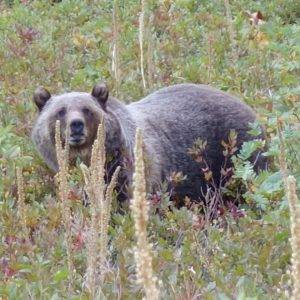As we ask CDT supporters to take this year’s Pledge to Protect, we wanted to help teach some of the ways you can best be a steward of the CDT! This post comes from our friends at Bear Vault, who are helping ensure that wildlife encounters remain safe for both humans and animals.
By Sarah Leichnetz, photo by Matt Berger
Getting out in the wild creates opportunities for adventures of all shapes and sizes. While any trip has the potential for heart-pounding thrills or jaw-dropping views, outdoor and backpacking experiences are extra memorable when there is a wildlife encounter. There is almost nothing more exciting for both the seasoned and first-time outdoor explorer than a bear sighting.
Most bear encounters happen when the bear is searching for food, with its cubs, or wandering through its territory. More often than not a bear encounter is a surprise to both hiker and bear. A ready response in these situations depends on what you know about bears, as well as some good old-fashioned common sense. At BearVault, each of our bear encounters have taught us that a positive experience can boil down to being prepared in 3 main areas: knowledge of the bears and area you are visiting, proper equipment, and mentally practicing possible scenarios. Let’s check these out in a little further detail.
1) Knowledge: Things To Know Before You Go!
- Are you in black bear or grizzly bear country? These North American bears are not always two of a kind. Find out where they roam and research the difference in the look and behavior of the two.
- PRO TIP: Call the National Park Service, U.S. Forest Service, or other land managers and trail associations to chat with them about the bear activity in the area you are visiting.
- Research the behavior of habituated bears versus wild bears. Find out what happens to a bear that comes in contact with human food and why this is usually a turning point that determines the outcome of a bear’s life.
- Become familiar with identifying bear habitats, where they might eat, drink, sleep, and hide.
- Learn the seasons for mating and behavior for caring for cubs. Connect what you learn with the info you get about the area you are visiting.
2. Equipment: Smart Tools For Safe Trekking
- Choose backcountry food that is easy to keep contained, cleaned, and doesn’t leave a sticky mess on clothes and other gear.
- PRO TIP: Food storage is one of the most important things you can do to preserve the life of a bear. Always store your food properly in a portable or fixed bear-resistant container, such as a Bear Vault. Once a bear accesses human food, they never stop looking for it and can engage in problematic behaviors like entering campsites and becoming unafraid of humans. This may lead to the bear needing to be relocated or put down.
- Trail users need a plan for their trash! Trash is smelly and contains traces of leftover food. Use durable, freezer-strength ziplock or reusable silicone bags to keep trash compact and sealed in your food canister.
- Yelling, clapping, and talking are effective ways of alerting a bear to your presence. Audibly engaging in your outdoor activity can let a bear know where you are without alarming it. Bear bells, while popular, typically do not effectively warn a bear you are in the area according to the US National Parks Service.
- Bear spray is a personal preference for travelling in bear country, but may be a good precaution in many parts of the CDT. Call the area park service officials and discuss before making a decision. Research proper usage of bear spray thoroughly before taking it into the wild.
3. Practice: Mentally prepare before the bear encounter happens!
- Awareness is your first line of safety on the trail, so be on the lookout for bears. Watch for fresh tracks, scat, and other signs including torn up logs, digging, and fresh claw marks on trees. These are all good hints that bears are in the area.
- PRO TIP: At camp, be sure to store food in a bear-resistant food canister 100 yards away from your cook site and camping area. Do not cook or clean near your tent and store all scented items like toothpaste, sunscreen, and chapstick, in your can.
- Bears typically like to eat around dawn, dusk, and at night. Finish your cooking and tidy up before it gets dark.
- PRO TIP: If you’re traveling along the trail, stop and have a cooked meal a few miles before your intended campsite. After eating, you can travel well away from your cooking smells.
- Always keep a safe distance if you see a bear. No matter the temptation, do not try to get close enough for a better picture.
- Surprising a bear can create an unpredictable situation. If you notice a bear before it notices you, back away slowly and calmly, while keeping an eye on the bear. Never ever approach a bear that does not see you.
These tips are a great place to start readying yourself for the excitement of encountering bears in the wild. The most important thing you can do in any wildlife encounter is to never, ever feed them human food. If you remember that, you can save a furry life.
Sarah Leichnetz is a Bear Vault Employee

